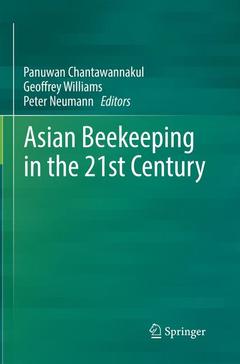Description
Asian Beekeeping in the 21st Century, 1st ed. 2018
Coordinators: Chantawannakul Panuwan, Williams Geoffrey, Neumann Peter
Language: English
Subject for Asian Beekeeping in the 21st Century:
Publication date: 01-2019
Support: Print on demand
Publication date: 06-2018
Support: Print on demand
Description
/li>Contents
/li>Biography
/li>Comment
/li>
From the perspective of local scientists, this book provides insight into bees and bee
management of Asia, with a special focus on honey bees.
Asia is home to at least nine honey bee species, including the introduced European honey
bee, Apis mellifera. Although A. mellifera and the native Asian honey bee, Apis cerana,
are the most commonly employed species for commercial beekeeping, the remaining
non-managed native honey bee species have important ecological and economic roles
on the continent. Species distributions of most honey bee species overlap in Southeast
Asia, thus promoting the potential for interspecies transmission of pests and parasites,
as well as their spread to other parts of the world by human translocation.
Losses of managed A. mellifera colonies is of great concern around the world, including
in Asia. Such global colony losses are believed to be caused, in part, by pests and
parasites originating from Asia such as the mite Varroa destructor, the microsporidian
Nosema ceranae, and several bee viruses.
Taking advantage of the experience of leading regional bee researchers, this book provides
insight into the current situation of bees and bee management in Asia. Recent
introductions of honey bee parasites of Asian origin to other parts of the world ensures
that the contents of this book are broadly relevant to bee scientists, researchers, governmentoffi cials, and the general public around the world.
Insights from local scientists/experts and bee researchers, who worked on bee heath, local & traditional knowledge, beekeeping techniques in their countries which are not available in published articles
Provides new and up-to-date information on detailed beekeeping practice and distribution of bee pests and pathogens
One book covering all bee species and beekeeping practices in Asia for the world




